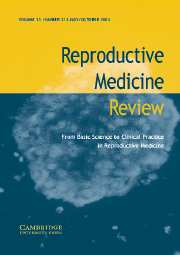Crossref Citations
This article has been cited by the following publications. This list is generated based on data provided by Crossref.
Hipkin, L J
1993.
The XY female in sport: the controversy continues..
British Journal of Sports Medicine,
Vol. 27,
Issue. 3,
p.
150.
Batch, J A
Evans, B A
Hughes, I A
and
Patterson, M N
1993.
Mutations of the androgen receptor gene identified in perineal hypospadias..
Journal of Medical Genetics,
Vol. 30,
Issue. 3,
p.
198.
Clarkson, P A
Davies, H R
Williams, D M
Chaudhary, R
Hughes, I A
and
Patterson, M N
1993.
Mutational screening of the Wilms's tumour gene, WT1, in males with genital abnormalities..
Journal of Medical Genetics,
Vol. 30,
Issue. 9,
p.
767.
Williams, D M
Patterson, M N
and
Hughes, I A
1993.
Androgen insensitivity syndrome..
Archives of Disease in Childhood,
Vol. 68,
Issue. 3,
p.
343.
Walker, Moanna M.
and
Hughes, Ieuan A.
1994.
Ambiguous genitalia.
Current Paediatrics,
Vol. 4,
Issue. 3,
p.
161.
Yong, Eu Leong
Chua, Kim Lee
Yang, Mary
Roy, Ashim
and
Ratnam, Shan
1994.
Complete androgen insensitivity due to a splice-site mutation in the androgen receptor gene and genetic screening with single-stranded conformation polymorphism.
Fertility and Sterility,
Vol. 61,
Issue. 5,
p.
856.
Zajac, J.D.
and
Warne, G.L.
1995.
Disorders of sexual development.
Baillière's Clinical Endocrinology and Metabolism,
Vol. 9,
Issue. 3,
p.
555.
Davles, Helen R.
Hughes, Leuan A.
and
Patterson, Mark N.
1995.
Genetic counselling in complete androgen insensitivity syndrome: trinucleotide repeat polymorphisms, single‐strand conformation polymorphism and direct detection of two novel mutations in the androgen receptor gene.
Clinical Endocrinology,
Vol. 43,
Issue. 1,
p.
69.
Yong, EL
Wang, Q
Tut, TG
Ghadessy, FJ
and
Ng, SC
1997.
Male infertility and the androgen receptor: molecular, clinical and therapeutic aspects.
Reproductive Medicine Review,
Vol. 6,
Issue. 2,
p.
113.
Meschede, D.
Behre, H. M.
and
Nieschlag, E.
1997.
Andrology.
p.
207.
Wang, Q.
Ghadessy, FJ
and
Yong, EL
1998.
Analysis of the transactivation domain of the androgen receptor in patients with male infertilitv.
Clinical Genetics,
Vol. 54,
Issue. 3,
p.
185.
Diamond, Milton
and
Watson, Linda Ann
2004.
Androgen insensitivity syndrome and Klinefelter's syndrome: sex and gender considerations.
Child and Adolescent Psychiatric Clinics of North America,
Vol. 13,
Issue. 3,
p.
623.
Minto, Catherine L.
2004.
Paediatric and Adolescent Gynaecology.
p.
275.
Islam, Rumana
Lane, Sheila
Williams, Suzannah A.
Becker, Christian M.
Conway, Gerard S.
and
Creighton, Sarah M.
2019.
Establishing reproductive potential and advances in fertility preservation techniques for XY individuals with differences in sex development.
Clinical Endocrinology,
Vol. 91,
Issue. 2,
p.
237.


